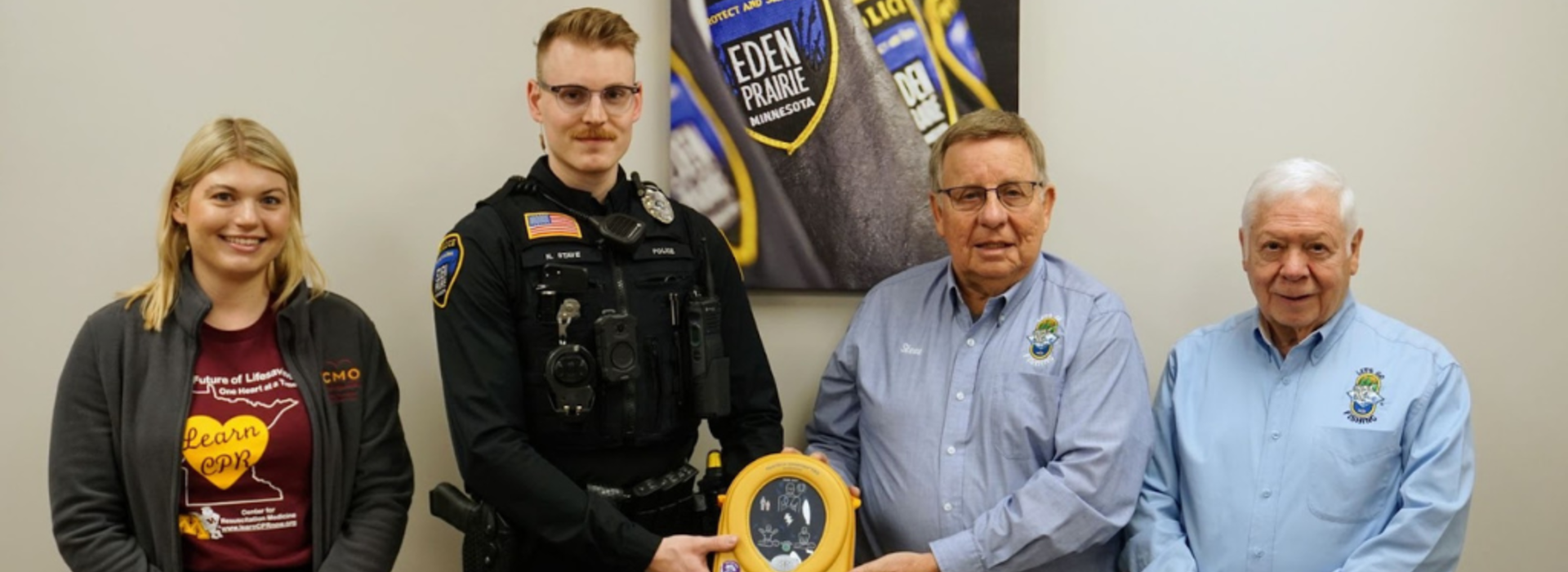
Center for Resuscitation Medicine donates life-saving devices to Eden Prairie Police Department
MINNEAPOLIS/ST. PAUL (02/06/2024) — The Center for Resuscitation Medicine at the University of Minnesota Medical School donated 25 new Automated External Defibrillator (AED) units to the Eden Prairie Police Department. This initiative is part of the Hearts on Duty program, a collaborative effort between Stryker Medical Inc. and The Helmsley Charitable Trust, aimed at recognizing and celebrating the role of law enforcement officers in saving lives through AEDs.
AEDs play a vital role in cardiac arrest by analyzing a person's heart rhythm and delivering an electric shock, if necessary, to restore a normal heartbeat. AEDs can significantly increase cardiac arrest survival rates by reducing pauses in CPR and improving blood circulation.
"The Hearts on Duty program allows us to recognize and appreciate the amazing work that law enforcement does every day and the lives they save in their communities," said Kim Harkins, MPH, the program manager for the Center for Resuscitation Medicine.
The Eden Prairie Police Department has previously utilized AED devices, resulting in a documented save on Mar. 4, 2023. The collaboration between the Center for Resuscitation Medicine and the Eden Prairie Police Department facilitated the application and acquisition of the AED unit through Hearts on Duty.
The Eden Prairie Police Department gave one AED to the Let’s Go Fishing chapter in Eden Prairie, who are an outreach partner for the department. The organization takes 20 children and several officers out on their boats every summer for our Cops and Bobbers event.
The donated AED units have advanced features, including Wi-Fi connectivity and self-monitoring capabilities. These features allow remote monitoring of device status, ensuring they are always prepared for use in emergencies. The Center for Resuscitation Medicine utilizes this data to enhance responses to cardiac arrest incidents, showcasing the impact of swift law enforcement response on survival rates.
The U of M Medical School’s Minnesota AED Project will nominate an agency every quarter to acknowledge their efforts in saving lives during cardiac arrests. Additionally, the Center for Resuscitation Medicine and Minnesota AED Project are actively working on integrating donated AEDs and others into the PulsePoint AED app. This aims to enhance communication and location tracking during cardiac events, ultimately contributing to improved outcomes and survival rates.
###
About the University of Minnesota Medical School
The University of Minnesota Medical School is at the forefront of learning and discovery, transforming medical care and educating the next generation of physicians. Our graduates and faculty produce high-impact biomedical research and advance the practice of medicine. We acknowledge that the U of M Medical School, both the Twin Cities campus and Duluth campus, is located on traditional, ancestral, and contemporary lands of the Dakota and the Ojibwe, and scores of other Indigenous people, and we affirm our commitment to tribal communities and their sovereignty as we seek to improve and strengthen our relations with tribal nations. For more information about the U of M Medical School, please visit med.umn.edu.
For media requests, please contact:
Ezra Xiong
Communications Specialist
xion1913@umn.edu
University of Minnesota Medical School